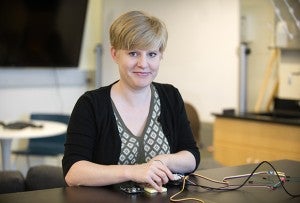
Megan Maksimowicz is passionate about research, and she gets a lot of practice at it as a graduate student in the Department of Geosciences. A Wichita native, Maksimowicz received her undergraduate degree from the University of Kansas in Lawrence before moving to Boise.
Maksimowicz is in her first semester of the master of science in hydrological sciences program at Boise State University. Hydrological science is the study of the movement and transportation of water through the Earth’s systems.
Choosing her area of emphasis was a fairly easy decision: “I kept running into the science of water in my studies, and as an undergrad I worked for the U.S. Geological Survey as a lab technician. We studied contaminants in water like antibiotics, hormones, pesticides and herbicides, and that got me thinking about how we assume that when you turn on the faucet, the water is always going to be clean and there is always going to be some,” she said.

Maksimowicz also spent two years living in Tanzania as a Peace Corps volunteer teaching math and physics to high school students. Water is a closely guarded resource in that region, a fact that further cemented her decision to study hydrological sciences.
“When I was in Tanzania, water was a big issue. The pipes by where I lived could go out for three weeks at a time. I had seven buckets of water that I would store, and there would be times you would start getting toward the bottom of that seventh bucket and you were thinking, ‘I don’t know what I’m going to do here. I guess I’m going to have to go to town and get a shower and drink water,’” she said. “It really made me realize how much we take water for granted, and with things like the drought and what’s going on right now in Flint, it just reaffirms that I really want to study our planet’s most important resource.”
Maksimowicz is an avid reader and outdoorswoman and is enjoying getting to know her adopted city. She spent her first winter in Boise taking part in some of the local traditions and experiences, visiting the Idaho Botanical Gardens Winter Garden aGlow and trying snowshoeing over Christmas break. Family is important to Maksimowicz, and she’s looking forward to returning to Kansas this summer to be a bridesmaid in her brother’s wedding.

When she isn’t donating her time to a worthy cause, taking classes or working on campus as a teaching assistant and lab instructor for Geosciences 101, she can be found working on her research. She’s currently working on a project in conjunction with Greg Carr, Boise State University and the Mozambican government to help restore Gorongosa National Park in Africa. This summer Maksimowicz will be headed to Mozambique to work with Boise State geosciences professor Lejo Flores.
“Primarily what I’m doing is working on a computer model of how water and water systems move,” she said. “Gorongosa National Park went through civil conflict for about 12 years and it resulted in a great deal of land use change.”.
The park also has been the site of extreme poaching; however with the civil unrest in the past and the economy slowly recovering, the area of Gorongosa National Park is slowly rebounding.
“I’m going to be studying how that land cover changed throughout that time period, with the use of satellite imagery, and then evaluate how that land use change has possibly altered the hydro-meteorological cycles,” Maksimowicz said. “We’re hoping we can also gather more data through the use of Arduino technology that we are building through a combined service-learning project. We are going to try and build meteorological stations and put them out into Gorongosa National Park.”
Arduino technology is an open source, buildable circuitry technology. It is easily adaptable for many uses and also extremely cost-effective and fairly easy to maintain.
Arduino weather stations monitor variables like temperature, precipitation, humidity and soil moisture. In the United States, this type of data is easily accessible, with stations set up at almost every airport to monitor this information.
“With this technology we’re hoping we can get the same kind of continuous information and observable data from a part of the world that doesn’t typically have that kind of information available to researchers,” Maksimowicz said. “The goal is to get the technology set up, and then the park staff can maintain it so we can keep the influx of data and scientific observations coming in.”
She said that projects like Gorongosa provide unique opportunities for Boise State students.
“The circumstances that happened here, although tragic, provide an opportunity for researchers to examine the potential ramifications for the people and wildlife in that area, as well as the natural resources themselves, and that’s something you can’t recreate in a lab.”
For Maksimowicz, the importance of research projects like this are very clear: they provide detailed observational information that hasn’t been readily available in the past regarding climate, weather, meteorology and hydrology.
“Weather is all global and through projects like this maybe we can find ways to improve that for our planet and future generations,” she said.
Student Research Spotlight is an occasional series in Update looking at the student research experience. To nominate a student researcher, email kathleentuck@boisestate.edu.
By Becca Burke
BY: KATHLEEN TUCK PUBLISHED 1:42 PM / FEBRUARY 2, 2016